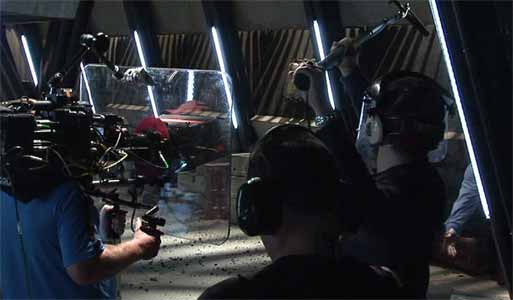|
Click here to return to the main site. Battlestar Galactica: Sight and Sound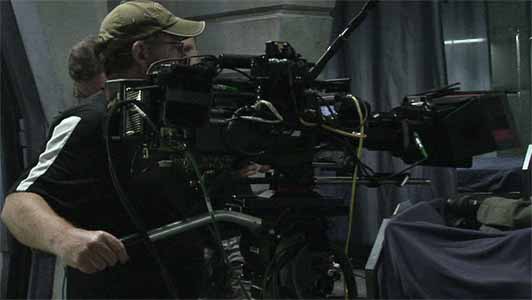 Just like the best of written science fiction, Galactica is open to many interpretations, its combination of the purely visual and metaphysical and its exploration of cosmology and ontology made for a rich brew which attempted to explore the religious and philosophical monoliths which at the same time unite and divide us as a race. A contextual or deterministic examination of the show would fill a book. However, over the course of three articles, Charles Packer hopes to give a glimpse of where Galactica came from, its reflection on what it is to be human and the technical tricks it used along the way...
This language grew out of the silent age, when often technical limitations precluded the use of deep focus lenses or the swooping shots with which we are now familiar. The earliest Lumiere brothers films may look quaint now, but those first shots of a train coming into a station had audiences ducking. As film makers progressed different styles both artistic and technical started to appear. Galactica is a product of those hundred odd years of visual development and in this last article I propose to take a look at some of the key concepts of film making and editing so that you can apply them the next time you watch an episode to enhance your enjoyment and impress the hell out of your friends.
The idea of dividing fiction into genres is an important one as it allows the study of a particular cultural artefact and the various influences acting upon it. There are two general approaches to studying film and television. The first approach is Functional; this sees the story of having a much wider reference to the society which created it, a form of social commentary, which highlights the concerns of the socioeconomic and political background to their creation. Although the various concerns change through the decades, as we saw in the second of these articles science fiction has dealt with, amongst others, the fear of communist infiltration (Invasion of the Body Snatchers. 1956); Ecological disaster (Soylent Green. 1973. The Day the Earth Stood Still. 2008) as well as the creation of artificial life (Frankenstein. 1931). In this sense the film becomes a shared cultural experience, reflecting back the society from which it was born. Galactica was not above using a science fiction show as a basis for social commentary; in fact, it was an important element in the overall character driven drama.
Realistically, any examination of a show or film will have to take a both approaches, allowing the show to be both a product of its genre history and as a product of the society which created it. This way of looking at the show not only extends to the themes and concepts which it wishes to include but also how it is physically created. It may be like stating the obvious, but everything you see on the screen is a fabrication, the costumes the sets, the script and the characters. When you're reading a piece like this restating this may seem a little insulting, but then how many time have you been drawn into a fictional world and never thought about how its constructed? Like any other art form film has its own language and that language of shot type and editing gives birth to the programme's structure.
When you look at the screen everything which exists in the fictional world is called the diegesis which encompasses the whole of the shows narrative structure, which can be further broken down into the mise-en-scène and the mise-en-shot, both of which exist in a box. If you study the shot from Flight of the Phoenix you can see that there exists a space between the background and the camera where the action can be made to move away or towards the audience, there also exist the possibility of characters or objects entering the scene from either left or right. You, as the viewer occupy the space where, if this were a box, the forth wall would exist. Sometimes the structure of the shot may appear random, after all there is no obvious symmetry in the shot from the Flight of the Phoenix, but at other times, such as the establishing shot for Caprica’s introduction, the whole shot including the scenery is translated into a symmetry which forces the viewer attention towards the centre of the screen. This use of the set to focus the audience onto a particular area is also used in the introductory shot of princess Leia in Star Wars, which uses symmetrical shapes on either side of the shot to frame the princess and R2D2.
Mise-en-scène covers everything which has been placed in the scene for you to look at. Remember that none of it represents random junk, but is the result of careful thought by the set designer, costumer, lighting director and the director, who chooses whom to show and how to place the actors. Not all that you see in the scene will have a special significance, but none of it is a random collection of objects which combine to represent a specific reality. Only documentaries attempt to reproduce our reality, and although the reality within the Mise-en-scène is a fiction its various elements must work together to persuade us that we are seeing something real. Sometimes shots are constructed due to budgetary limitations and in the days before CGI the angle of the shots would be dictated as much by cost, for example the production could only afford to build the set to a specific height.
So once you have your environment and the cast of characters, the director has to decide how to shoot this to get their desired effect. Mise-en-shot is the process by which these disparate elements are made to move and interact. This process is usually broken down into a number of elements such as camera angle, depth of focus, the scale of the shot (long shot, medium shot or close up), the positioning of the camera, how it moves in relation to the objects moving on the screen, how long the shot is and the pace of the editing. The choice of shot depends on what the director is trying to tell the audience, so should we be concentrating on a particular person, how do we know where this action is taking place?
The medium shot is the one that is most used, as it both places the characters in their environment whilst at the same time allowing interaction. Even though this shot is mostly used for the continuation of the narrative its structure can tell you a lot more. Consider the shot of Adama and Tigh on the bridge, just what does this composition tell us? Both men have an equal share of the frame and are shot so that their stature is generally equal. The subliminal message of this shot is that even though they may be of different ranks they consider themselves to be equals, a fact which is borne out by their conversations and treatment of each other. Now consider the shot of Starbuck talking to a fellow pilot, Kat. Both women are in shot but Starbuck is standing closer to the camera which makes her look bigger than she is. She is also looking down on Kat, which reinforces the fact that Starbuck feels superior to Kat. She is literally looking down on her both in a figurative and literal way. Once again this reinforces the two women’s feeling for each other.
So we have our basic shots, but what do we do with them. Well this is where editing rears its head. It is often true that good editing will not make a classic but bad editing can ruin even the best film. Two main types of editing exist. The first is the most understandable and is termed Continuity editing where the shots are collected together to create a seamless narrative. A good example of this is found in the miniseries where the camera zooms into the Galactica - thereby establishing that the action will take place on the ship - we then cut to Kara Thrace who is jogging thought the ship's corridors. Along the way she passes, and we are introduced to, various characters until the sequence ends with her meeting Adama, at which point the focus shifts to his character. The second type of editing is Montage where a sequence of shots are strung together to create a meaning which the audience must deduce for themselves. This type of editing is rarely used, to any great degree, outside of Auteur and art house films as it can have a tendency to make the action disjointed, which is not the natural way we experience reality. The transitional points between scenes can be spliced together with any number of fade, wipes and sudden cuts. The type of cut will influence the tempo of the filmed shots, and short scenes with sudden cut are used to enhance action and excitement.
The one thing that hasn’t really be covered is how the camera is used in Galactica, and for this the creators often used a technique from Cinema-vérité, which uses hand held cameras to impart a sense of action and urgency to a sequence. This technique was extended to the battle scenes which often looked like they had been filmed on a hand held, this included zooms and jump cuts. This often meant that you were given more of an impression of the chaos of battle and is a world away from most science fiction shows which seem to work on the principle that if you’ve spent a ton on the special effects then the audience wants to see them on the screen. When watching an episode the last thing to consider is the narrative structure, which generally falls into the categories cause and effect, character motivation, disequilibrium, turning points, exposition and narration, which itself is subdivided into restricted and omnipotent narration. But that is a discussion for another day. So next time you watch Galactica remember that a lot of thought went into what you’re looking at. Learning to read the language of what you’re watching really can help you enjoy a well constructed show and spot a real stinker.
Return to... |
|---|
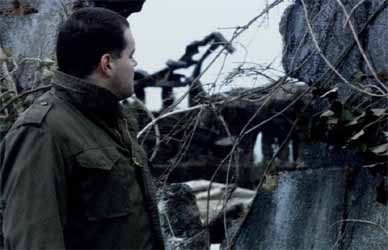 I guess, like most people, when I started to become aware of cinema it was at an early age and its primary appeal for me was one of spectacle. I wanted to be entertained and preferably shown something that I had never seen before. Sometimes the story would stay with me sometimes not, but the images were the strongest thing I took away from the experience. Cinema and television are primarily a visual medium, which may be stating the obvious, but less obvious is the fact that pictures don’t just happen. As an artefact they are not just random images they are specifically created and composed by the director and editor. Over the last century the language of film has developed and alongside that a vocabulary to describe what is being shown. This is as true of Science Fiction as it is of any genre and the composition of the visual can often differentiate between a good and bad film.
I guess, like most people, when I started to become aware of cinema it was at an early age and its primary appeal for me was one of spectacle. I wanted to be entertained and preferably shown something that I had never seen before. Sometimes the story would stay with me sometimes not, but the images were the strongest thing I took away from the experience. Cinema and television are primarily a visual medium, which may be stating the obvious, but less obvious is the fact that pictures don’t just happen. As an artefact they are not just random images they are specifically created and composed by the director and editor. Over the last century the language of film has developed and alongside that a vocabulary to describe what is being shown. This is as true of Science Fiction as it is of any genre and the composition of the visual can often differentiate between a good and bad film.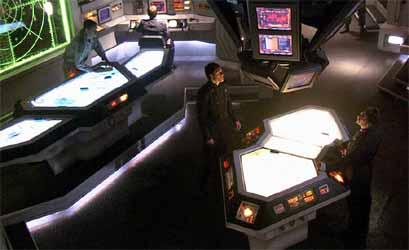 Science Fiction is a genre of speculative fiction which derives its impetus from the influence of a real or imagined advance in science and its impact on either individuals or societies. Although as a genre it is often delineated into two camps, the first being ‘hard’ science fiction, which is either based on a known or possible technological basis and ‘soft’ science fiction which usually takes the humanities - sociology, psychology - as its jumping off point. Shows like Galactica tend to be a fusion of both. To make things easier I shall mostly refer to anything, serial, or feature, which has been visually created as film.
Science Fiction is a genre of speculative fiction which derives its impetus from the influence of a real or imagined advance in science and its impact on either individuals or societies. Although as a genre it is often delineated into two camps, the first being ‘hard’ science fiction, which is either based on a known or possible technological basis and ‘soft’ science fiction which usually takes the humanities - sociology, psychology - as its jumping off point. Shows like Galactica tend to be a fusion of both. To make things easier I shall mostly refer to anything, serial, or feature, which has been visually created as film.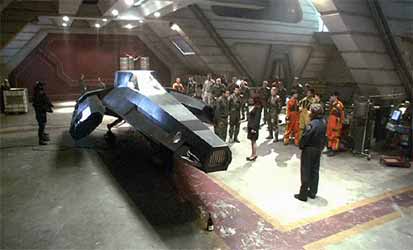 The second is Descriptive which places the show alongside others of its type, this allows for the exploration of any common themes and images, so an examination of the two Galactica shows would highlight some of their differences and similarities , as well as allowing a broader look at how this fits in with other science fiction media. This was the approach which was taken in the last article, where some elements of the show were juxtaposed whilst others were discussed in relation to the wider field of science fiction, but not the society which created it.
The second is Descriptive which places the show alongside others of its type, this allows for the exploration of any common themes and images, so an examination of the two Galactica shows would highlight some of their differences and similarities , as well as allowing a broader look at how this fits in with other science fiction media. This was the approach which was taken in the last article, where some elements of the show were juxtaposed whilst others were discussed in relation to the wider field of science fiction, but not the society which created it.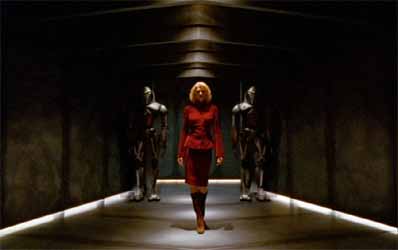 The reality is that as an audience you are placed into the role of voyeur, not participant, no action on your part can affect what you see. This agreed relationship often allows the audience to distance themselves from the action, though there are some films like Michael Powell’s Peeping Tom (1960) which exploit this relationship to unsettle the audience. In the film the serial killer dispatches his victims with a blade which extends from his camera tripod, which allows him to record their deaths and with the use of a mirror allows the victim to witness their own death. The camera angle often places the audience in the uncomfortable space which should be occupied by the actor thereby making the audience a participant in the killings.
The reality is that as an audience you are placed into the role of voyeur, not participant, no action on your part can affect what you see. This agreed relationship often allows the audience to distance themselves from the action, though there are some films like Michael Powell’s Peeping Tom (1960) which exploit this relationship to unsettle the audience. In the film the serial killer dispatches his victims with a blade which extends from his camera tripod, which allows him to record their deaths and with the use of a mirror allows the victim to witness their own death. The camera angle often places the audience in the uncomfortable space which should be occupied by the actor thereby making the audience a participant in the killings.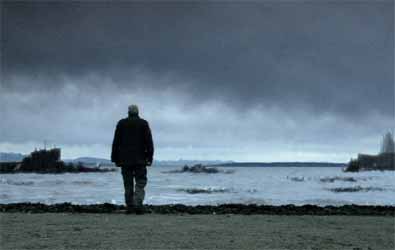 In some commentaries you will see critics refer to the forth wall and for the most part film rarely breaks the forth wall, an example of this would be if the actor spoke directly to the audience as if they could see you. This isn’t often done as it throws up the contrast between a fictional reality and your own, reinforcing the fact that the film is a fake. The actor doesn’t really know that you're there and will repeat the same sequence of behaviours each time you watch. Sometime the forth wall is broken in a way which maintains the fiction as in, for instance, when the Star Destroyer appears to fly from above and behind the audience in the opening sequence of the first Star Wars film. There are some moments of Galactica breaking the forth wall, though these tend to be to occasional shot placing the audience in the space normally occupied by a viper pilot.
In some commentaries you will see critics refer to the forth wall and for the most part film rarely breaks the forth wall, an example of this would be if the actor spoke directly to the audience as if they could see you. This isn’t often done as it throws up the contrast between a fictional reality and your own, reinforcing the fact that the film is a fake. The actor doesn’t really know that you're there and will repeat the same sequence of behaviours each time you watch. Sometime the forth wall is broken in a way which maintains the fiction as in, for instance, when the Star Destroyer appears to fly from above and behind the audience in the opening sequence of the first Star Wars film. There are some moments of Galactica breaking the forth wall, though these tend to be to occasional shot placing the audience in the space normally occupied by a viper pilot.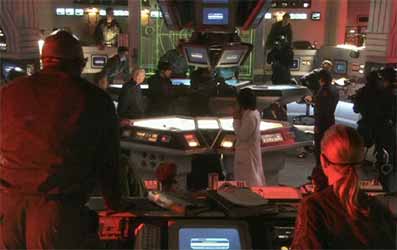 Apart for a small number of episodes Galactica was mainly shot on a sound stage. However Galactica did shoot on location for the stories involving new Caprica, Kobol, Earth and Caprica. Here lighting played a major part in creating another planet. If we examine the shot of the destroyed Earth, we can clearly see that the director has gone for a combination of blues and greys which signify cold and desolation, colours which were also used in New Caprica. In contrast Caprica is shown as a lush warm planet, here the colour palette used is a combination of greens and reds. Colours shifted towards the red end of the spectrum are perceived by human beings as warm. There are few instances in Galactica when the use of colour and lighting are not designed to create a specific feeling in the audience, the only time this happens is during the show's ending which used a much more naturalistic pallet of colours.
Apart for a small number of episodes Galactica was mainly shot on a sound stage. However Galactica did shoot on location for the stories involving new Caprica, Kobol, Earth and Caprica. Here lighting played a major part in creating another planet. If we examine the shot of the destroyed Earth, we can clearly see that the director has gone for a combination of blues and greys which signify cold and desolation, colours which were also used in New Caprica. In contrast Caprica is shown as a lush warm planet, here the colour palette used is a combination of greens and reds. Colours shifted towards the red end of the spectrum are perceived by human beings as warm. There are few instances in Galactica when the use of colour and lighting are not designed to create a specific feeling in the audience, the only time this happens is during the show's ending which used a much more naturalistic pallet of colours.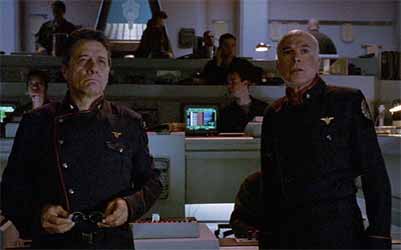 Generally the long shot - shots of the bridge, planets or ships - is used to signify location and are often referred to as establishing shots, if it is an internal shot it works by placing the characters in a particular environment. Occasionally a long shot will be used to signify the actor’s insignificance in an environment. David Lean used this technique in Lawrence of Arabia (1962), where Lawrence is filmed moving towards the camera, the shots length is extremely long, the point being that the actor starts off being nothing but a dot on the screen which grows bigger as he moves towards the camera, but by this time the audience has been given a visceral visual representation of just how vast the desert is. Establishing shots can also be used to save money. The scale of New Caprica is presented in it establishing shot, allowing the director to use medium shots as the scale of the tented city has already been implanted in the audience mind.
Generally the long shot - shots of the bridge, planets or ships - is used to signify location and are often referred to as establishing shots, if it is an internal shot it works by placing the characters in a particular environment. Occasionally a long shot will be used to signify the actor’s insignificance in an environment. David Lean used this technique in Lawrence of Arabia (1962), where Lawrence is filmed moving towards the camera, the shots length is extremely long, the point being that the actor starts off being nothing but a dot on the screen which grows bigger as he moves towards the camera, but by this time the audience has been given a visceral visual representation of just how vast the desert is. Establishing shots can also be used to save money. The scale of New Caprica is presented in it establishing shot, allowing the director to use medium shots as the scale of the tented city has already been implanted in the audience mind.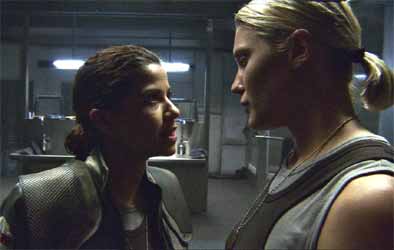 The last type of shot is the close up which is generally used to convey a facial reaction or to concentrate the audience’s attention on just a single figure, who hopefully will be saying something that we as an audience need to listen to.
The last type of shot is the close up which is generally used to convey a facial reaction or to concentrate the audience’s attention on just a single figure, who hopefully will be saying something that we as an audience need to listen to.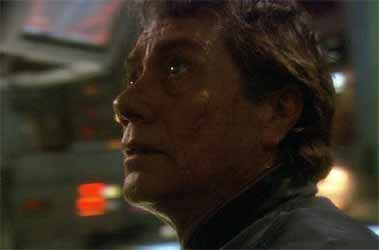 The last main element which creates the fictional world is the music and sound effects. These may be diegetic, that is, they form the part of the narrative which would cover the actor voices, but also any other forms of sound that they may make. This would include Kara Thrace playing the piano, but would also include ‘All along the Watchtower’ as the music was coming from within the fictional world. The soundtrack is non-diegetic because it is something which we, as the audience hear, but the characters do not.
The last main element which creates the fictional world is the music and sound effects. These may be diegetic, that is, they form the part of the narrative which would cover the actor voices, but also any other forms of sound that they may make. This would include Kara Thrace playing the piano, but would also include ‘All along the Watchtower’ as the music was coming from within the fictional world. The soundtrack is non-diegetic because it is something which we, as the audience hear, but the characters do not.